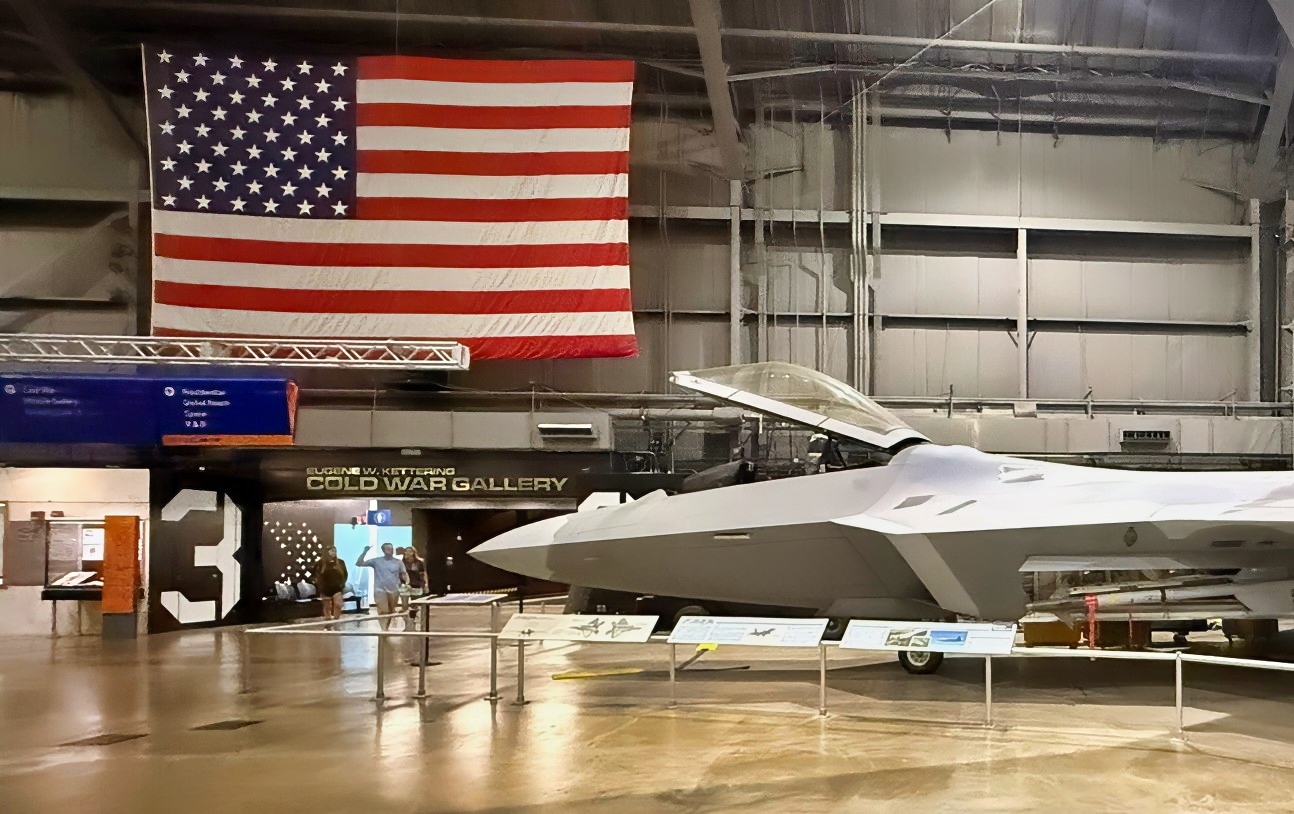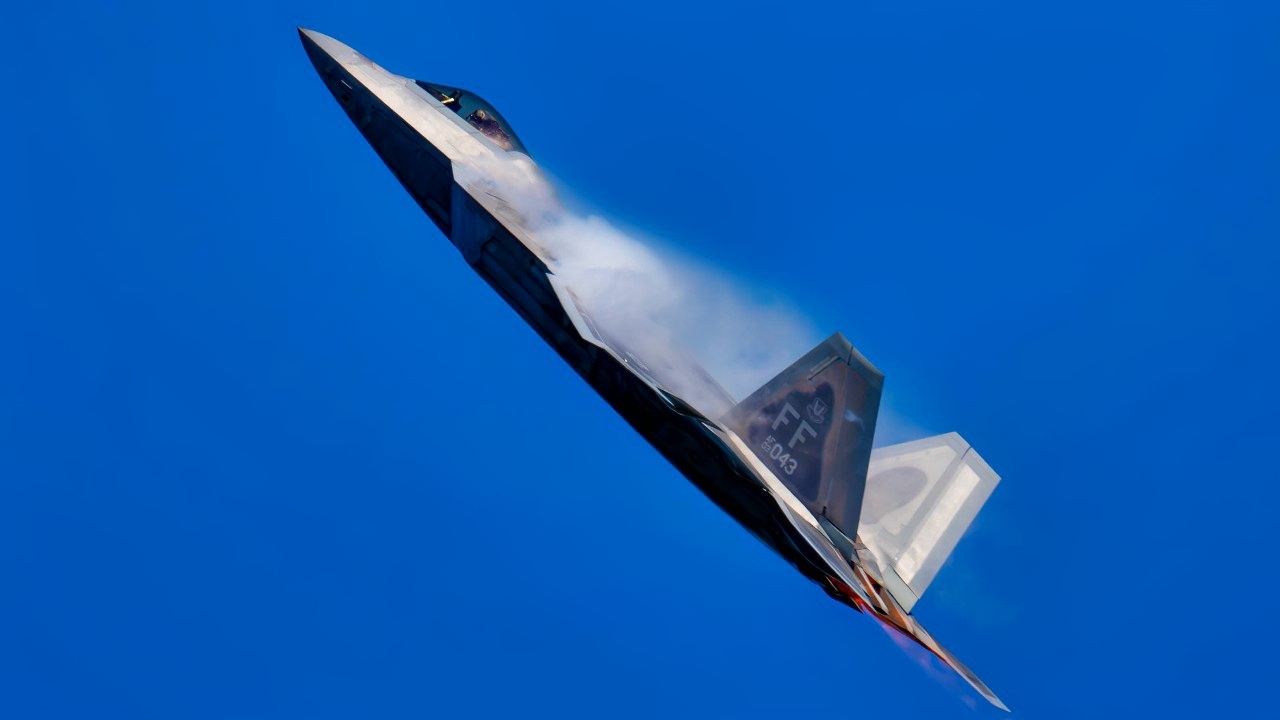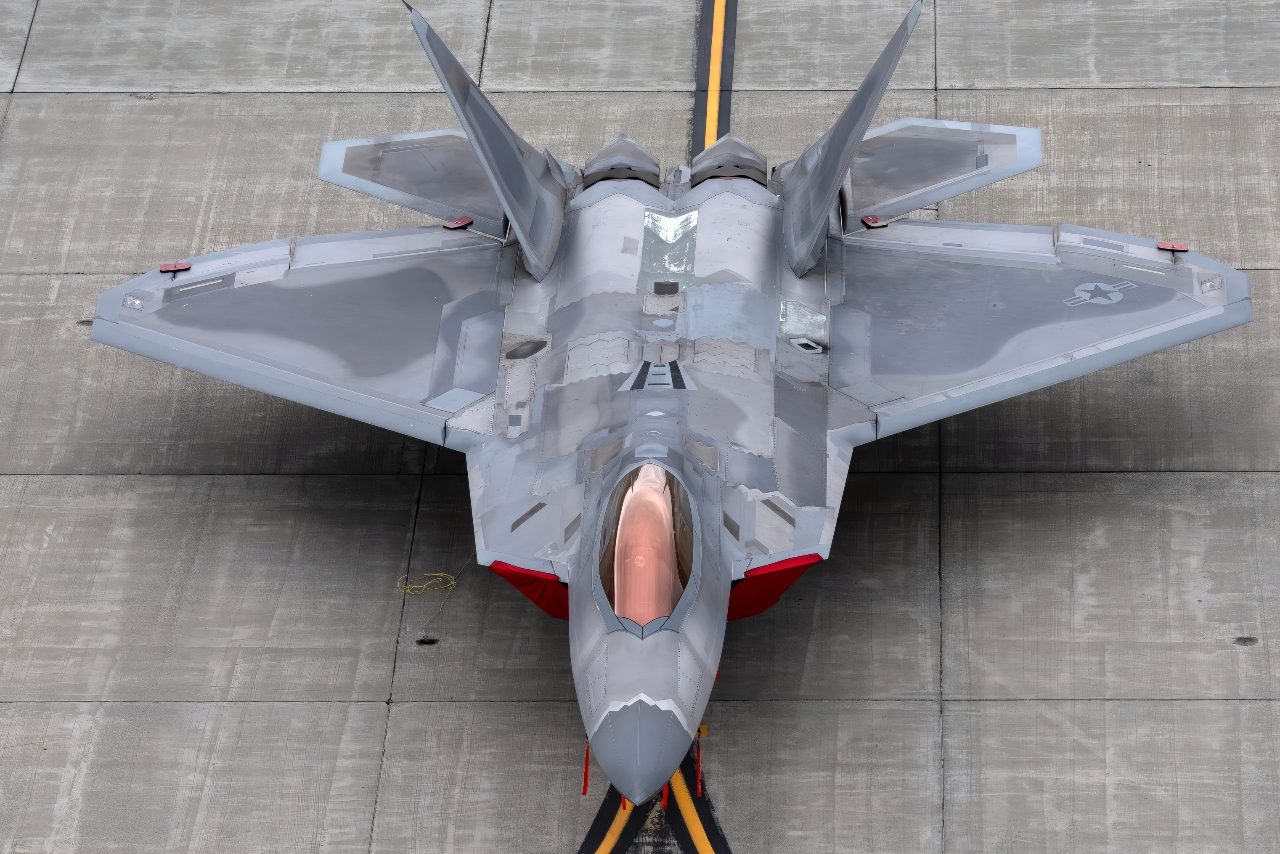Key Points and Summary – The F-22 Raptor remains the world’s most dominant air superiority fighter, a true apex predator designed for absolute control of the skies.
-Its supremacy is built on five key pillars: a generational leap in all-aspect stealth that makes it a tactical ghost; unmatched kinematic performance, including supercruise and thrust-vectoring agility; pioneering sensor fusion that turns it into a “quarterback in the sky”; its role as a purebred air-to-air killer; and a continuous modernization program that keeps the combat-proven platform ahead of all rivals. It is the benchmark against which all other fighters are measured.

F-22A Raptor in the Air Force Museum. Image Credit: National Security Journal Original Photo.
The F-22 Is a Legend for 5 Reasons
In the pantheon of great military aircraft, a few names achieve a legendary status that transcends their technical specifications.
They become symbols of an era, embodiments of a nation’s technological will. For the 21st century, no aircraft has earned this distinction more profoundly than the F-22 Raptor.
In fact, back in July, I visited the F-22 Raptor at the U.S. Air Force museum in Dayton, Ohio, where it is on display. It is beyond impressive to say the least. Many of the pictures and videos from that visit are in this article.
Born from the crucible of the Cold War’s end and designed to guarantee American control of the skies against any conceivable threat, the Raptor was, and remains, a machine built for a singular, brutal purpose: absolute and total air dominance.
While newer aircraft like the F-35 have rightfully earned praise for their multi-role, network-centric capabilities, a dangerous narrative has emerged that the F-22 is somehow a relic, an exquisite but aging fighter designed for a war that never came.
This could not be further from the truth.
Take it from me: in an era of renewed great power competition, where the skies over the Pacific or Eastern Europe could become the decisive battleground, the F-22’s unique combination of capabilities makes it more relevant, more vital, and more terrifyingly dominant than ever before.
To understand the F-22 is to understand the very definition of air superiority.

F-22 Raptor National Security Journal Image
Here are the five key reasons why the Raptor remains in a class entirely of its own.
A Generational Leap in Invisibility
The single greatest factor that defines the F-22 is not its speed or its agility, but its stealth. And this is not the radar-reduction of a 4.5-generation fighter like the Eurofighter Typhoon; it is a profound, all-aspect invisibility that remains the global benchmark.
The F-22 was the first aircraft where low-observability was not an afterthought but the central organizing principle of its entire design. Every surface, every edge, every intake and exhaust was meticulously shaped and aligned to deflect radar energy away from its source.
Its four internal weapons bays are a testament to this philosophy. While other fighters hang missiles and bombs from their wings, creating massive radar reflections, the Raptor carries its entire air-to-air payload internally, maintaining a perfectly clean and exceptionally stealthy profile.
This is then coated in layers of advanced Radar-Absorbent Material (RAM) that absorb the signals that aren’t deflected. The result is a frontal radar cross-section (RCS) reportedly the size of a steel marble. For an adversary’s radar, the F-22 is not a fighter jet; it is a ghost, a phantom that flickers at the very edge of detection, if it is detected at all.
This isn’t just a defensive advantage; it is the ultimate offensive weapon. It grants the F-22 pilot the priceless gift of tactical invisibility, allowing them to dictate the terms of every single engagement with the mantra of “first look, first shot, first kill.”
Unmatched Kinematic Supremacy
What makes the Raptor truly terrifying is that this generational leap in stealth is fused with a level of aerodynamic performance that no other fighter in service today can match. Its competitors, like China’s J-20, are forced to make compromises between stealth and agility.
The F-22 makes none. It is an apex predator that is both invisible and a world-class athlete.
The foundation of this supremacy is its ability to supercruise—to fly at sustained speeds of Mach 1.5 or higher without the use of fuel-guzzling afterburners. This is a game-changing capability. While a conventional fighter must light its afterburners to go supersonic, drastically reducing its combat radius and creating a massive infrared signature for enemy sensors to track, the F-22 can cruise at supersonic speeds for extended periods.
This allows it to transit vast distances quickly, choose when and where to fight, and impart significantly more kinetic energy to its missiles, dramatically increasing their effective range.
This incredible speed is paired with a level of agility that borders on defying physics, made possible by its two Pratt & Whitney F119 engines equipped with two-dimensional thrust-vectoring nozzles.
These paddles can direct the engine’s immense thrust up or down by 20 degrees, allowing the F-22 to perform breathtaking post-stall maneuvers and maintain control at angles of attack where any other aircraft would simply fall out of the sky. In a visual-range dogfight, this allows an F-22 to point its nose—and its weapons—at an opponent with shocking speed.
The combination of stealth, supercruise, and thrust-vectoring agility creates a performance envelope that is simply untouchable.
The Original ‘Quarterback in the Sky’
Long before the F-35 was lauded for its sensor fusion, the F-22 was pioneering the concept.
The aircraft was designed from the outset not just as a fighter, but as a penetrating sensor node. Its brain is the AN/APG-77 Active Electronically Scanned Array (AESA) radar, a revolutionary system that was years ahead of its time and remains incredibly potent.

USAF Capt. Nick “Laz” Le Tourneau, F-22 Raptor Aerial Demonstration Team pilot and commander, performs a practice demonstration at Joint-Base Langley-Eustis, 17 March, 2025. Laz is the only F-22 Raptor pilot in the world certified to fly the demonstration. (U.S. Air Force photo by Staff Sgt. Michael Bowman)
Unlike older mechanically scanned radars, the APG-77 can scan vast volumes of airspace with incredible speed and can switch between air-to-air and air-to-ground modes almost instantaneously.
Crucially, it also has a low-probability-of-intercept (LPI) capability, meaning it can radiate powerful radar energy without triggering the radar warning receivers of enemy aircraft. It can see them when they have no idea they are being watched. But the radar is only one piece of the puzzle.
The F-22’s computers fuse data from the radar with its other advanced sensors, including its electronic warfare suite, to create a single, intuitive picture of the battlespace for the pilot.
This allows a Raptor pilot to have a god’s-eye view of the conflict.
They can see not just enemy fighters, but also the location of surface-to-air missile batteries and other threats, all while remaining a ghost to the enemy. This unparalleled situational awareness means that in any engagement, the F-22 pilot will always have more information and more time to make decisions than their adversary.
They enter every fight knowing exactly where the enemy is, what they are doing, and how best to destroy them.
A Purebred Air-to-Air Killer
The F-35 is a jack-of-all-trades; the F-22 is the master of one: ruling the sky. Every aspect of its design is optimized for the air superiority mission. Its internal bays are configured to carry a deadly payload of six AIM-120 AMRAAM beyond-visual-range missiles and two AIM-9 Sidewinder heat-seeking missiles for close-in fights.
This potent loadout, combined with its other capabilities, makes for a lethal formula.

F-22 Raptor. Image Credit: Creative Commons.
Let’s wargame a typical engagement. An F-22, supercruising at 50,000 feet, detects a flight of enemy fighters over 120 miles away. The enemy pilots see nothing. The F-22 pilot, operating from an untouchable perch of high altitude and high speed, launches their AMRAAMs.
The missiles, already starting with a massive energy advantage from the Raptor’s speed and altitude, streak towards their targets. By the time the enemy aircraft receive a terminal missile warning, it is far too late. The F-22 can destroy an entire enemy formation before they are ever within range to return fire.
It is a deeply unfair fight, and that is precisely the point. The F-22 was not built to engage in a fair fight; it was built to guarantee an American victory.
A Combat-Hardened and Evolving Platform
While the F-22’s production was tragically cut short, the existing fleet of roughly 185 aircraft has been far from static. The Raptor is a combat-proven platform, having flown missions over Syria where it operated in complex air environments, deterring Russian and Syrian aircraft and acting as a high-value command-and-control asset.
More recently, it has been used to defend North American airspace, famously downing a Chinese surveillance balloon.
More importantly, the U.S. Air Force is investing billions of dollars in a continuous modernization program to ensure the Raptor remains ahead of emerging threats.
These upgrades include new, more advanced sensors, next-generation stealth coatings that are easier to maintain, enhanced electronic warfare suites, and the integration of the latest AIM-120D and AIM-9X missiles.
The Air Force is also developing new software and data links to allow the F-22 to better network with the F-35 and other assets, ensuring it remains a critical node in the joint force. This is not a legacy platform being left to wither; it is a prized asset being constantly sharpened for the high-end fight.

YF-118G Bird of Prey and F-22 Raptor. Image Taken at U.S. Ai Force Museum on 7/20/2025.
F-22 Raptor: A League of Its Own
The decision to prematurely terminate the F-22 production line will likely be remembered as one of the most significant strategic blunders of the post-Cold War era. In a world where the skies are once again contested, the demand for the Raptor’s unique capabilities has never been higher. Its small numbers are its only actual vulnerability.
But even with a limited fleet, the F-22 Raptor remains the undisputed king of air-to-air combat. Its synthesis of all-aspect stealth, breathtaking kinematic performance, advanced sensor fusion, and purebred lethality creates a machine that is more than the sum of its parts.
It is the ultimate expression of air dominance, a weapon system so practical that it can clear the skies of any adversary and guarantee that America’s other forces can operate without fear from above.
The F-22 is not just one of the best fighters on Earth; it is the benchmark against which all others are measured, and they all fall short.
About the Author: Harry J. Kazianis
Harry J. Kazianis (@Grecianformula) is Editor-In-Chief and President of National Security Journal. He was the former Senior Director of National Security Affairs at the Center for the National Interest (CFTNI), a foreign policy think tank founded by Richard Nixon based in Washington, DC. Harry has over a decade of experience in think tanks and national security publishing. His ideas have been published in the NY Times, The Washington Post, The Wall Street Journal, CNN, and many other outlets worldwide. He has held positions at CSIS, the Heritage Foundation, the University of Nottingham, and several other institutions related to national security research and studies. He is the former Executive Editor of the National Interest and the Diplomat. He holds a Master’s degree focusing on international affairs from Harvard University.
More Military
Russia’s Su-34 Fullback Is a Punisher Bomber
China’s New H-20 Stealth Bomber Is Coming










